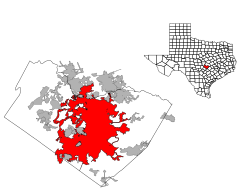Blog Subject
- Subscribe to RSS Feed
- Mark as New
- Mark as Read
- Bookmark
- Subscribe
- Printer Friendly Page
- Report Inappropriate Content
- Feature this Article
Austin, Texas
| Austin, Texas | ||
|---|---|---|
| City | ||
| City of Austin | ||

Downtown skyline as seen from Lady Bird Lake
|
||
|
||
 Location in the state of Texas |
||
| Location in the United States of America | ||
Coordinates:  30°15′0″N 97°45′0″WCoordinates: 30°15′0″N 97°45′0″WCoordinates:  30°15′0″N 97°45′0″W 30°15′0″N 97°45′0″W |
||
| Country | ||
| State | ||
| Counties | Travis, Williamson, Hays | |
| Settled | 1835 | |
| Incorporated | December 27, 1839 | |
| Government | ||
| • Type | Council–manager | |
| • Mayor | Steve Adler (D) | |
| • City Manager | Marc Ott | |
| Area | ||
| • City | 271.8 sq mi (704 km2) | |
| • Land | 264.9 sq mi (686 km2) | |
| • Water | 6.9 sq mi (18 km2) | |
| • Metro | 4,285.70 sq mi (11,099.91 km2) | |
| Elevation | 489 ft (149 m) | |
| Population (2014[1]) | ||
| • City | 912,791 (11th) | |
| • Density | 3,358.32/sq mi (1,296.65/km2) | |
| • Metro | 1,943,299 (35th) | |
| • Demonym | Austinite | |
| Time zone | CST (UTC-6) | |
| • Summer (DST) | CDT (UTC-5) | |
| ZIP code | 78701–78705, 78708–78739, 78741–78742, 78744–78769 | |
| Area code(s) | 512 & 737 | |
| FIPS code | 48-05000[2] | |
| GNIS feature ID | 1384879[3] | |
| Website | Official website | |
Austin (![]() i/ˈɒstᵻn, ˈɔː-/[4]) is the capital of the US state of Texas and the seat of Travis County. Located inCentral Texas, Austin is the 11th-most populous city in the United States and thefourth-most populous city in Texas. It is the fastest growing of the largest 50 US cities.[5]Austin is also the second largest state capital in the United States, after Phoenix, Arizona.[6] As of July 1, 2014, Austin had a population of 912,791 (U.S. Census Bureau estimate). The city is the cultural and economic center of theAustin–Round Rock metropolitan area, which had an estimated population of 1,943,299 as of July 1, 2014.
i/ˈɒstᵻn, ˈɔː-/[4]) is the capital of the US state of Texas and the seat of Travis County. Located inCentral Texas, Austin is the 11th-most populous city in the United States and thefourth-most populous city in Texas. It is the fastest growing of the largest 50 US cities.[5]Austin is also the second largest state capital in the United States, after Phoenix, Arizona.[6] As of July 1, 2014, Austin had a population of 912,791 (U.S. Census Bureau estimate). The city is the cultural and economic center of theAustin–Round Rock metropolitan area, which had an estimated population of 1,943,299 as of July 1, 2014.
In the 1830s, pioneers began to settle the area in central Austin along the Colorado River. After Republic of Texas Vice President Mirabeau B. Lamar visited the area during a buffalo-hunting expedition between 1837 and 1838, he proposed that the republic's capital, then located in Houston, be relocated to the area situated on the north bank of the Colorado Rivernear the present-day Congress Avenue Bridge. In 1839, the site was officially chosen as the republic's new capital (the republic's seventh and final location) and was incorporated under the name Waterloo. Shortly thereafter, the name was changed to Austin in honor of Stephen F. Austin, the "Father of Texas" and the republic's first secretary of state.
The city grew throughout the 19th century and became a center for government and education with the construction of the Texas State Capitol and the University of Texas at Austin.[7] After a lull in growth from the Great Depression, Austin resumed its development into a major city and, by the 1980s, it emerged as a center for technology and business.[8] A number of Fortune 500 companies have headquarters or regional offices in Austin includingAdvanced Micro Devices, Apple Inc., ARM Holdings, Cisco, eBay,Google, IBM, Intel, Texas Instruments, 3M, Oracle Corporation and Whole Foods Market.[9] Dell's worldwideheadquarters is located in nearby Round Rock, a suburb of Austin.
Residents of Austin are known as Austinites.[10] They include a diverse mix of government employees (e.g., university faculty and staff, law enforcement, political staffers); foreign and domestic college students; musicians; high-tech workers; blue-collar workers and businesspeople.[11] The city is home to development centers for many technology corporations; it adopted the "Silicon Hills" nickname in the 1990s. However, the current official slogan promotes Austin as "The Live Music Capital of the World", a reference to the many musicians and live music venues within the area, and the long-running PBS TV concert series Austin City Limits.[12][13] In recent years, some Austinites have also adopted the unofficial slogan "Keep Austin Weird".[14] This interpretation of the classic "Texas-style" sense of independence refers to a desire to protect small, unique, local businesses from being overrun by large corporations.[15] In the late 1800s, Austin also became known as the City of the "Violet Crown" for the wintertime violet glow of color across the hills just after sunset.[16]Even today, many Austin businesses use the term "violet crown" in their name. Austin is known as a "clean-air city" for the city's stringent no-smoking ordinances that apply to all public places and buildings, including restaurants and bars.[17] The FBI ranked Austin as the second-safest major city in the U.S. for the year 2012.[18]


